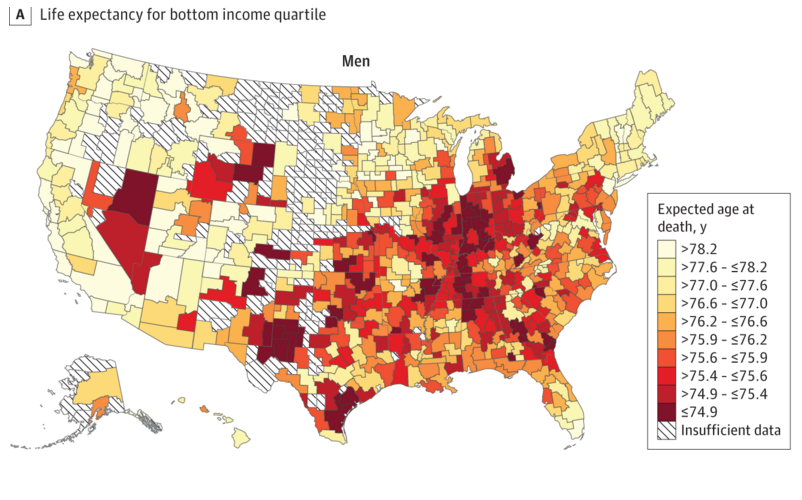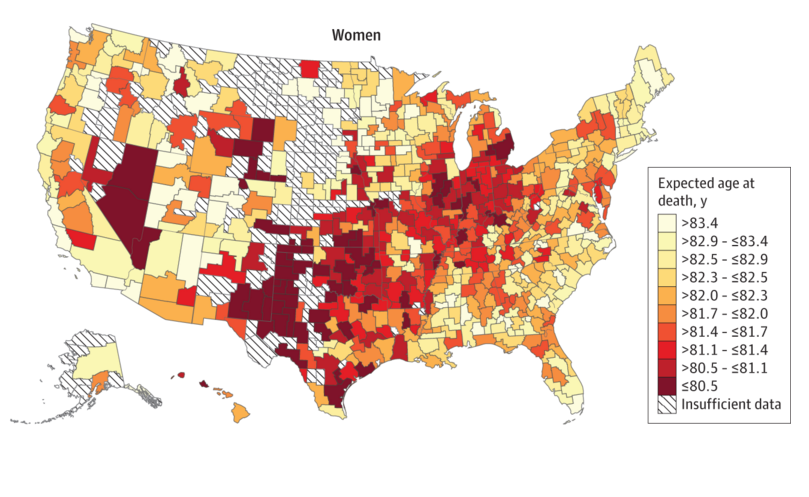There aren’t many economists whose research findings are routinely reported in the New York Times and Washington Post. But Raj Chetty—and his colleagues around the country—have a justly earned reputation for clearly presented analyses with detailed findings and direct policy relevance. Last year, they released the most detailed study yet on how place affects intergenerational mobility. And the paper they released Monday is the latest to draw a link between the qualities of urban spaces and the most profound issues of opportunity—in this case, life expectancy.
The bulk of the paper concerns the relationship between longevity and income, and has been well-reported elsewhere. It highlights patterns that anyone following issues of inequality in the US would have long suspected to be true—that life expectancy is strongly correlated with income, and that the gap in life expectancy between high- and low-income people has grown—but which are now confirmed, in detail, in hard numbers.
But because Chetty et al also analyzed their data by commuting zone (akin to a metropolitan area) and county, we can also draw important conclusions about the link between place and life expectancy, just as their earlier research linked place and economic opportunity. And it appears that strong urban environments can boost their residents’ longevity—especially for the low-income.
Before exploring the details, an important note: the Chetty paper takes only a first-pass, high-level look at correlations between geographic variables and life expectancy. This analysis shows the simple and direct relationship between each tested variable and life expectancy—but doesn’t measure any interactions among variables. And the standard caveat applies: correlation doesn’t prove causation. Still, by examining the correlation between selected local characteristics and life expectancy, we can begin to answer some of our questions about what aspects of place affect this aspect of quality of life.


Here we’ve reproduced a key chart from Chetty’s paper, which shows the correlation between a series of regional characteristics and the life expectancy of people in the bottom income quartile.

Dots correspond to the point estimate, lines represent the 95 percent confidence interval of the estimate. Positive values indicate that life expectancy increases with increases in the local characteristic; negative values indicate that life expectancy decreases as the value of the local characteristic increases.
We can split these findings into three categories:
Confirming the obvious. places where people smoke more and where obesity is more prevalent have shorter life expectancies; places where people exercise more have longer life expectancies. Regional variations in key health behaviors are reflected directly in the life expectancy of the poor.
Little evidence for the expected. Chetty et al looked at the role of a range of health care measures, the presence of social capital, and the role of inequality and of unemployment and found that regional variations in these characteristics had weak, if any correlation with regional variations in life expectancy.
Unexpected importance of place. Strikingly, poor people tend to live longer in places with more immigrants, more expensive housing, higher local government spending, more density, and a better educated population. Consider each of the five characteristics in the category “Other Variables” at the bottom of Chetty, et al’s Figure 8.
What these data show are a string of strong positive correlations. Places with more immigrants have longer life expectancy for the poor. The same holds for places with more expensive housing: here, too, the poor live longer. The poor also live longer in places with high levels of government spending, more density, and a better educated population. Taken together, these correlations suggest the importance of positive spillover effects from healthy urban places. Large cities tend to have higher levels of density. The most successful cities tend to attract more immigrants, have more expensive housing, and a better educated population. These data suggest that the poor have longer life expectancies in thriving cities.
The authors explain that their data make a strong case for a relationship between cities and greater longevity of the poor:
. . . the strongest pattern in the data was that low-income individuals tend to live longest (and have more healthful behaviors) in cities with highly educated populations, high incomes, and high levels of government expenditures, such as New York, New York, and San Francisco, California. In these cities, life expectancy for individuals in the bottom 5% of the income distribution was approximately 80 years. In contrast, in cities such as Gary, Indiana, and Detroit, Michigan, the expected age at death for individuals in the bottom 5% of the income distribution was approximately 75 years. Low-income individuals living in cities with highly educated populations and high incomes also experienced the largest gains in life expectancy during the 2000s.
As noted, these correlations don’t show causation; some of the effect may have something to do with those—like immigrants—who self-select to move to cities. But the strength of these correlations (and their absence for other variables like access to medical care) signals a need for further scrutiny.
There’s long been a good body of circumstantial evidence to support the proposition that cities are healthier. We know the people in cities and denser environments tend to walk more, a key factor associated with longevity. They also tend to drive less, and suffer less from the toll of crashes and the sedentary life styles associated with car dependent living.
“Live long and prosper” was Spock’s famous admonition in Star Trek. Together with the earlier research on the connections between place and inter-generatinal mobility, this new work highlighting the role of community characteristics in influencing life expectancy signals that successful cities may be an important contributor to realizing those twin goals.
